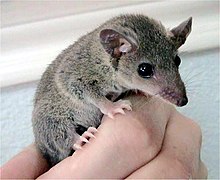Gray short-tailed opossum
| Gray short-tailed opossum[1] | |
|---|---|

| |
| Scientific classification | |
| Domain: | Eukaryota |
| Kingdom: | Animalia |
| Phylum: | Chordata |
| Class: | Mammalia |
| Infraclass: | Marsupialia |
| Order: | Didelphimorphia |
| Family: | Didelphidae |
| Genus: | Monodelphis |
| Species: | M. domestica
|
| Binomial name | |
| Monodelphis domestica (Wagner, 1842)
| |

| |
| Gray short-tailed opossum range | |
| Synonyms | |
|
Monodelphis domesticus | |
The gray short-tailed opossum (Monodelphis domestica) is a small South American member of the
Description
Gray short-tailed opossums are relatively small animals, with a superficial resemblance to voles. In the wild they have head-body length of 12 to 18 cm (4.7 to 7.1 in) and weigh 58 to 95 grams (2.0 to 3.4 oz); males are larger than females.[5] However, individuals kept in captivity are typically much larger, with males weighing up to 150 grams (5.3 oz).[6] As the common name implies, the tail is proportionately shorter than in some other opossum species, ranging from 5 to 9 centimetres (2.0 to 3.5 in).[5] Their tails are only semi-prehensile, unlike the fully prehensile tail characteristic of the North American opossum.[3]
The fur is greyish brown over almost the entire body, although fading to a paler shade on the underparts, and with near-white fur on the feet. Only the base of the tail has fur, the remainder being almost entirely hairless.
Distribution and habitat
The gray short-tailed opossum is found generally south of the Amazon River, in southern, central, and western Brazil. It is also found in eastern Bolivia, northern Paraguay, and in Formosa Province in northern Argentina.[2] It inhabits rainforest environments, scrubland, and agricultural land, and often enters man-made structures, such as houses.[5] There are no recognised subspecies.
Behaviour
Gray short-tailed opossums eat
They are
Reproduction
The opossums breed year round when the climate is suitable, being able to raise up to six litters of six to eleven young each during a good year. Females only come into
Gray short-tailed opossums are sexually mature at five to six months of age, and live for up to forty-nine months in captivity.[5]
Laboratory opossum

The gray short-tailed opossum possesses several features that make it an ideal
References
- OCLC 62265494.
- ^ .
- ^ a b Smith, P. "Grey Short-Tailed Opossum" (PDF). Retrieved 18 March 2017.
- SFBR. Archived from the originalon 2007-08-13. Retrieved 2007-04-13.
- ^ doi:10.1644/760.
- PMID 4039362.
- PMID 11465861.
- PMID 1947228.
- PMID 8371092.
- ^ Encyclopedia of Life
- .
- PMID 14559788.
- PMID 34038789.
- PMID 17495919.
- ^ "Monodelphis_domestica - Ensembl genome browser 104".
External links
 Media related to Monodelphis domestica at Wikimedia Commons
Media related to Monodelphis domestica at Wikimedia Commons- Know Your STO (Short-tailed Opossums) , pet care website by Molly Kalafut
- View the opossum genome on Ensembl.

